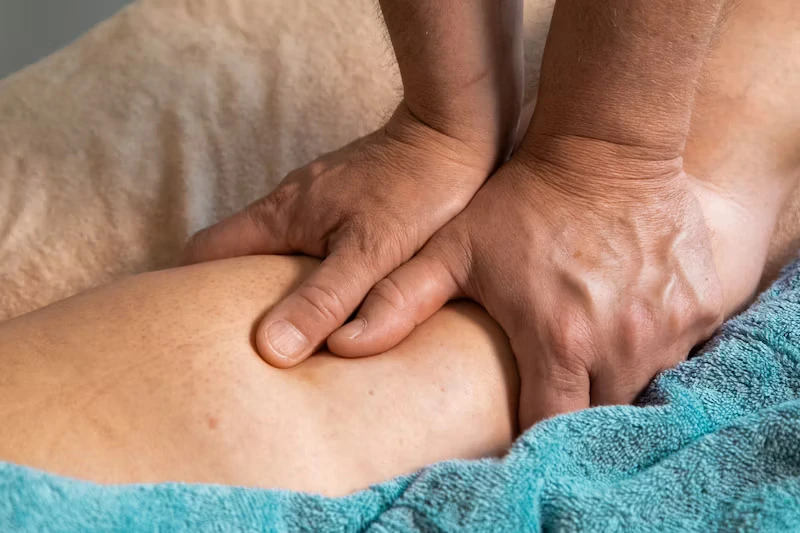Looking for leg cramp relief solutions? cramps can strike at any time, leaving us feeling uncomfortable and in pain. Whether you’re an athlete, a regular gym-goer, or simply suffer from them during the night, leg cramps can be a real hindrance to our daily life. But don’t worry.
Leg cramps, those sudden and painful muscle contractions that can disrupt even the most peaceful moments, are a universal discomfort experienced by many. Whether you’re a fitness enthusiast, an active individual, or someone who faces these cramps during restful nights, finding relief is crucial to maintaining your daily rhythm. In this comprehensive guide, we delve into the world of leg cramps, uncovering their causes and sharing practical, evidence-based tips to alleviate the discomfort and regain control over your life.
Relief is within reach. This article covers the causes of leg cramps and some practical, easy-to-follow tips for getting relief from these pesky cramps.
Understanding Leg Cramps. What Are Leg Cramps?
We are reader supported and may receive a commission for any products we recommend that are purchased.

Leg cramps are sudden, involuntary contractions or spasms in the muscles of the leg. These spasms can be very painful and can last anywhere from a few seconds to several minutes. Leg cramps can occur in any part of the leg, but they are most common in the calf muscles.
Leg cramps, scientifically known as involuntary muscle contractions or spasms, manifest suddenly and unexpectedly, creating a sharp sensation that can linger from seconds to minutes. While they can manifest in various leg parts, the calf muscles are the most common site for these cramps to strike. Whether they surprise you in the middle of sleep or interrupt your physical activities, leg cramps can be uncomfortable and hinder your daily routine.
They can happen while you are sleeping or during physical activity, and may be caused by a variety of factors, including dehydration, overuse of muscles, electrolyte imbalances, nerve damage, or certain medications. Leg cramps are generally harmless, but they can be very uncomfortable and may interfere with your ability to perform everyday activities.
What Causes Leg Cramps?

Leg cramps stem from a multitude of factors, each contributing to the discomfort in its own way. Some of the common culprits include:
Dehydration
Dehydration, a condition where your body lacks adequate fluids, can spark leg cramps. Electrolyte imbalances due to insufficient hydration disturb the delicate equilibrium that your muscles require for smooth functioning.
Muscle Overuse or Injury
Engaging in intense physical activity or overusing your leg muscles can result in cramping. When muscles are pushed beyond their capacity, they can react with spasms and contractions.
Electrolyte Imbalances
Your body relies on electrolytes like potassium and magnesium for proper muscle function. Imbalances in these electrolytes, often stemming from an inadequate diet, can lead to the development of leg cramps.
Nerve Damage
Nerve damage, whether due to underlying medical conditions or injuries, can disrupt the signals your muscles receive from the nervous system, potentially leading to spasms.
Medical Conditions and Medications
Medical conditions such as diabetes, kidney disease, and circulatory issues, along with certain medications, can increase the likelihood of leg cramps. Pregnant women may also experience cramps due to the physiological changes in their bodies.
Age and Inactivity
As we age, our muscles can become more susceptible to cramping. Additionally, sitting or standing for extended periods can lead to reduced blood circulation and, consequently, cramping.
Leg cramps can be caused by various factors, including:
- Dehydration
- Electrolyte imbalances
- Overuse or injury to muscles
- Nerve damage
- Medical conditions such as diabetes, kidney disease, or circulation problems
- Pregnancy
- Certain medications
- Age
- Inactivity or sitting for long periods of time.
The Sensation of Leg Cramps. What Does a Leg Cramp Feel Like?
A leg cramp often feels like a sudden, intense tightening or spasm in the muscle, which can be very painful. The affected muscle may feel hard and knotted, and you may experience a sharp or shooting pain that can last from a few seconds to several minutes. Some people describe the sensation as a “charley horse” or intense muscle cramping.
After the cramp subsides, you may feel sore or tender in the affected area for several hours or even days. The pain can be severe enough to interfere with your ability to walk or stand, particularly if the cramp occurs in the calf muscles.
Unlocking Leg Cramp Relief. 7 Leg Cramps Relief
There are several things you can do to relieve leg cramps, including:
- Stretching: Gently stretching the affected muscle can help to relieve the cramp. Straighten your leg and flex your foot upward toward your knee, holding the stretch for 30 seconds.
- Massage: Massaging the cramped muscle can help to relax it and reduce pain. Use your hands or a massage tool to gently knead the affected area.
- Apply heat or cold: Applying heat or cold to the cramped muscle can help to relieve pain and reduce inflammation. Try using a heating pad or ice pack wrapped in a towel for 10-15 minutes at a time.
- Stay hydrated: Dehydration can contribute to leg cramps, so make sure you are drinking plenty of water throughout the day.
- Adjust your diet: Some people find that increasing their intake of calcium, magnesium, and potassium can help to reduce the frequency of leg cramps. Try eating more foods like bananas, nuts, leafy green vegetables, and dairy products.
- Avoid standing or sitting for long periods: Prolonged periods of sitting or standing can increase the risk of leg cramps. Take breaks to stretch and move around, especially if you have a sedentary job.
How to Prevent Future Leg Cramps

There are several things you can do to prevent leg cramps from occurring, including:
- Stay hydrated: Dehydration can contribute to leg cramps, so it’s important to drink plenty of water throughout the day.
- Stretch regularly: Stretching your leg muscles regularly can help to prevent cramps. Focus on stretching your calf, hamstring, and quadriceps muscles.
- Warm-up before exercise: Always warm up before exercising, especially before engaging in activities that put a lot of strain on your legs.
- Wear proper footwear: Make sure your shoes fit well and provide adequate support for your feet and legs.
- Avoid standing or sitting for long periods: Prolonged periods of standing or sitting can increase the risk of leg cramps. Take breaks to move around and stretch.
- Increase your intake of electrolytes: Electrolytes, such as potassium and magnesium, play a role in muscle function. Try eating more foods rich in these minerals or consider taking a supplement.
- Consider your medications: Some medications, such as diuretics or statins, can increase the risk of leg cramps. Talk to your doctor if you are experiencing frequent cramps while taking medication.
Conclusion
In conclusion, leg cramps are a common inconvenience that can disrupt your routines and cause discomfort. By focusing on hydration, proper nutrition, and strategic muscle care, you can effectively manage and alleviate the impact of leg cramps. Empower yourself with knowledge and take proactive steps to ensure that cramps no longer hinder your quality of life
For more helpful articles join familyhint.com today!





